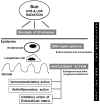Mechanisms of Photoaging and Cutaneous Photocarcinogenesis, and Photoprotective Strategies with Phytochemicals
- PMID: 26783703
- PMCID: PMC4665475
- DOI: 10.3390/antiox4020248
Mechanisms of Photoaging and Cutaneous Photocarcinogenesis, and Photoprotective Strategies with Phytochemicals
Abstract
Photoaging and photocarcinogenesis are primarily due to solar ultraviolet (UV) radiation, which alters DNA, cellular antioxidant balance, signal transduction pathways, immunology, and the extracellular matrix (ECM). The DNA alterations include UV radiation induced thymine-thymine dimers and loss of tumor suppressor gene p53. UV radiation reduces cellular antioxidant status by generating reactive oxygen species (ROS), and the resultant oxidative stress alters signal transduction pathways such as the mitogen-activated protein kinase (MAPK), the nuclear factor-kappa beta (NF-κB)/p65, the janus kinase (JAK), signal transduction and activation of transcription (STAT) and the nuclear factor erythroid 2-related factor 2 (Nrf2). UV radiation induces pro-inflammatory genes and causes immunosuppression by depleting the number and activity of the epidermal Langerhans cells. Further, UV radiation remodels the ECM by increasing matrixmetalloproteinases (MMP) and reducing structural collagen and elastin. The photoprotective strategies to prevent/treat photoaging and photocarcinogenesis include oral or topical agents that act as sunscreens or counteract the effects of UV radiation on DNA, cellular antioxidant balance, signal transduction pathways, immunology and the ECM. Many of these agents are phytochemical derivatives and include polyphenols and non-polyphenols. The flavonoids are polyphenols and include catechins, isoflavones, proanthocyanidins, and anthocyanins, whereas the non-flavonoids comprise mono phenolic acids and stilbenes. The natural sources of polyphenols include tea, cocoa, grape/wine, soy, pomegranate, and Polypodium leucotomos. The non-phenolic phytochemicals include carotenoids, caffeine and sulphoraphance (SFN). In addition, there are other phytochemical derivatives or whole extracts such as baicalin, flavangenol, raspberry extract, and Photomorphe umbellata with photoprotective activity against UVB radiation, and thereby carcinogenesis.
Keywords: extracellular matrix; polyphenols; signal transduction pathways; skin aging; skin cancer; ultraviolet radiation.
Figures
References
-
- Fisher G.J., Datta S.C., Talwar H.S., Wang Z.Q., Varani J., Kang S, Voorhes J.J. Molecular basis of sun-induced premature skin ageing and retinoid antagonism. 1996;379:335–339. - PubMed
Publication types
LinkOut - more resources
Full Text Sources
Other Literature Sources
Medical
Research Materials
Miscellaneous




